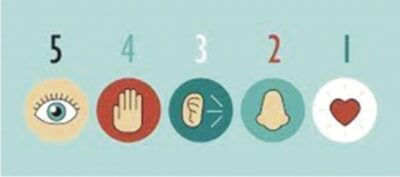Whenever you find yourself feeling anxious or stressed, you can use grounding techniques to reconnect with yourself and the present moment. This research-based strategy is helpful for anxiety, panic attacks, flashbacks, or even dissociation.
Grounding techniques work by “grounding” you in the present moment and pulling you away from intrusive thoughts or feelings. This refers not only to having your “feet on the ground” but also your “mind on the ground.” When you turn your attention away from thoughts, memories, or worries, you can refocus on the present moment (Fisher, 1999).
Grounding techniques are useful because they help you distance yourself from an emotional experience. When you experience negative emotions for example, perhaps you accidentally remember a painful memory the brain’s natural instinct is to start the involuntary physiological change known as the “fight or flight” response. Although this response keeps you safe by preparing you to face, escape from, or fight danger, memories do not present a tangible danger. If you find yourself in moments like these, grounding techniques can help the body calm itself and return to the present moment.
The 5-4-3-2-1 Technique

• 5 things you can see. Look around you and name five things you can see.
• 4 things you can feel. This is important because it makes you pay attention to your body.
• 3 things you can hear. Pay attention to your environment.
• 2 things you can smell. Smelling is a powerful sensation, yet sometimes we move through life without paying that much attention to it.
• 1 thing you can taste. Can you still taste lunch, coffee, or gum? If you want, grab a candy or mint and acknowledge how the flavours taste.
The next time you feel anxious or that you are overthinking a problem, try the 5-4-3-2-1 technique to become more present at the moment.
Do a Meditation Exercise
Guided meditation is a powerful grounding technique to reduce stress, depression and anxiety, and it can help you get out of your head and reconnect to your body. There are many types of meditation, such as the body scan, moving meditations, or loving-kindness meditation, so it’s important to try the one which works best for you. Meditation has been shown to reduce stress, make you calmer, promote happiness, and even reduce symptoms of PTSD.
Focus on Your Breath
Many clinical professionals use breathing exercises to help patients be present in the moment. Focusing on breathing is a great tool for reducing stress and anxiety.
Breathing exercises work because they help you disengage from your mind and not pay attention to distracting thoughts.
First, find a comfortable and quiet place to sit or lie down. Breathe in slowly through your nose and notice how your chest and belly rise as you fill your lungs. Then, breathe out slowly through your mouth. Do this a few times until you start to calm down.


COMMENTS